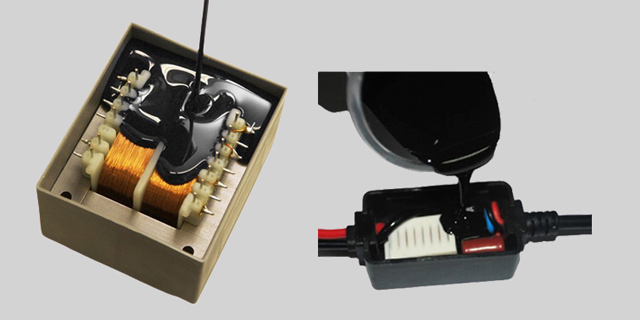
1. Introduction to common potting adhesives
Electronic potting glue Mainly used for bonding, sealing, potting and sealing of electronic components Coating protection. The potting glue is liquid before solidification and has fluidity. The viscosity of the glue varies according to the material, performance and production process of the product. Its use value can only be realized after it is completely cured. After curing, it can play the roles of waterproof, moisture-proof, dust-proof, insulation, heat conduction, confidentiality, anti-corrosion, temperature resistance and shock-proof. There are many types of electronic potting glue. Here we mainly introduce epoxy resin potting glue, Polyurethane potting glue, Silicone potting glue, etc.
1.Epoxy resin potting glue
<span style="; font-family: California It has the characteristics of fixation, insulation, waterproof, oil-proof, dust-proof, anti-theft, corrosion resistance, aging resistance, resistance to cold and heat shock, etc. Used in electronic transformers, ACcapacitors, negative ion generators, aquarium water pumps, ignition coils, electronic modules, LEDPackaging of modules, etc. Suitable for potting of small and medium-sized electronic components, such as automobile and motorcycle igniters, LEDdrive power supplies, sensors, and environmental protection equipment. Confidentiality, insulation and moisture-proofing of type transformers, capacitors, triggers, LEDwaterproof lamps, and circuit boards(Water)Potting.
Advantages: Most epoxy resin potting glues are hard, and there are also a few modified epoxy resins that are slightly softer. The biggest advantage of this material is that it has good adhesion to the material and good insulation, and the cured product has good acid and alkali resistance. Epoxy resin is generally temperature resistant100℃. The material can be used as a transparent material with good light transmittance. The price is relatively cheap.
Disadvantages: weak resistance to cold and heat changes, cracks are prone to occur after being subjected to cold and heat shocks, causing water vapor to seep into electronic components from the cracks, poor moisture resistance; the colloid hardness is high and brittle after curing, and the mechanical Stress can easily strain electronic components; once the epoxy resin is potted and solidified, it cannot be opened due to its high hardness, so the product is“lifetime“products cannot replace components; transparent epoxy resin materials generally have poor weather resistance and are prone to yellowing under light or high temperature conditions.
Application scope: Generally used for potting of non-precision electronic devices such asLED, transformers, regulators, industrial electronics, relays, controllers, power modules, etc.
2.Polyurethane potting glue
Polyurethane potting glue is PUpotting glue,Usually composed of polyols and diisocyanates, which are oligomers such as polyester, polyether and polydiene. Using glycol or diamine as chain extender, passed gradually aggregated. Potting glue can usually be prepared by prepolymer method and one-step process.
Polyurethane potting materials are characterized by low hardness, moderate strength, Good elasticity, Water-resistant, Anti-mold, Shockproof, TransparentPotting glue is mainly composed of basic resin, fillers, curing agents, cross-linking agents, and other auxiliaries. Among them, fillers And additives are the main factors affecting the settlement of potting glue. Therefore, when designing the formula of potting glue, these two aspects should be considered. Here, we mainly start from the perspective of filler. (Mainly silica powder commonly used in potting glue)
1.Filler particle size
For the same type of thermally conductive filler, the finer the particle size, the better the settling properties.
This is because the fine powder has a large specific surface area, a large content of surface hydroxyl groups, and strong hydrogen bonds between particles, resulting in a high viscosity, thereby slowing down the settling of the filler. However, the resulting excellent anti-settling properties will cause potting The glue has a higher viscosity, so it’s pointless. Common potting glues use fillers of different particle sizes to match the thickness. This compound can not only form a dense accumulation in the system, but the addition of coarse powder can also improve the thermal conductivity. More importantly, the coarse powder increases the viscosity of the system. Smaller, thick and fine powders are matched with each other, and the viscosity of the system can be flexibly adjusted to adjust the settleability.
2.Filler addition amount
Common fillers are inorganic powders. In the field of electronic potting glue, the common powder is silica powder (see the picture below). Compared with silicone oil, it has a higher density and fewer surface active groups; it has poor compatibility with silicone oil. As the standing time increases, the inorganic powder gradually settles, causing the oil powder to separate.
But when the amount of powder added reaches a certain amount, the viscosity of the colloid increases sharply, which slows down the settling speed of the thermally conductive filler and weakens the separation of oil powder. However, if the viscosity is too high, it will affect the process performance of the thermally conductive potting glue such as bubble release and potting during use, and the gain outweighs the loss. Therefore, we cannot blindly pursue excellent anti-settling properties and carry out high filling.
3.Surface properties of fillers
Use a surface treatment agent to coat the filler, and introduce non-polar lipophilic groups on the surface of the powder particles to make the modified powder It has good wettability in silicone oil, is easy to disperse evenly, is not easy to adhere and aggregate between particles, and has enhanced colloid anti-settling properties. At the same time, the surface treatment process can reduce the polarity of the powder and reduce the interfacial tension between the powder and silicone oil. The compatibility between the two is enhanced, which shows that the colloidal viscosity is lower. Therefore, in potting glue, in terms of improving its anti-settling ability, using modified fillers is better than ordinary fillers, and the viscosity will not increase.
Title of this article: Introduction to electronic potting glue and introduction to factors affecting settlement
Source of this article: http ://www.wellgo.com.cn/newb/information_2351.shtml



 微信扫一扫打赏
微信扫一扫打赏
